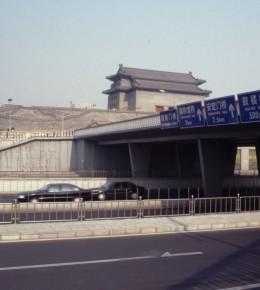The Motopias exhibition focuses on the repercussions of mobility on urban design in the twentieth century. A dozen historical concepts are used to clarify how the swift rise of modern traffic, in particular the car, has drastically changed our thinking about the city and the landscape. In the exhibition the historical objects and concepts are projected on large car windscreens/car windows/CHECK. Each object is discussed by a contemporary narrator, designer or researcher, who explains the plans and what – viewed from a present-day perspective – is revolutionary, important, or of current interest or has become outmoded.
Exhibition
Motopias
The acceleration, blurring and alienation of Motopias

- from May 7 to July 7, 2003
- Nederlands Architectuurinstituut (NAi)
- Museumpark 25, Rotterdam
- Credits

Since the end of the nineteenth century new modes of transport have demanded their place in cities; in this way they have changed the spatial logic of both the city and the land. Remote areas became readily accessible, while some city centres became inaccessible. Because of the acceleration of the traffic and man’ s increased scope of activity cities could develop into sprawling agglomerations with spaciously-designed districts set against a green backcloth. In contrast with this “dilution” of the city “densification” occurs in the central areas such as the shopping centres and amusement parks that attract millions of visitors.
Well before World War II the consequences of modern mobility for urban development were not recognised. The ideas took shape mainly in the form of ideals. In the nineteen-twenties Le Corbusier dreamt of buildings a hundred metres high the roofs of which supporting motorways, like urban serpentines winding their way through unspoilt landscapes. Russian “de-suburbanites” hoped to make the delights of the city and the countryside available to both farmers and workers alike, by spreading the cities out, as it were, along the thoroughfares. In America people had visions of suburbs with large plots of land and large houses. Thanks to the mass production of the T-Ford this dream soon became a reality.
Blessing
After the war the era of the mobile masses also dawned in Europe. Besides being a blessing it also created a big problem: the cities became congested and the countryside was inundated with city-dwellers. The city, traffic and landscape needed to be reconciled and harmony restored. The utopias conceived at the beginning of the century had to be adjusted to this reality. The designers took the existing cities into account and endeavoured to redress the human scale of the public space. This led to new typologies, such as the home zones, the pedestrianized street and pedestrian decks above the thoroughfares.
Meanwhile, the acceleration, blurring and alienation of the mobile man advanced. For some designers there was great vitality in the uncontrolled urbanisation along the traffic arteries, such as the strip in Las Vegas or the ring roads in Europe. Others reacted against the visual chaos and sought a new spatial language to tackle the urban periphery as an aesthetic assignment. Mobile cities have long since become a reality, but as far as the historical utopias are concerned only fragments are recognisable.

